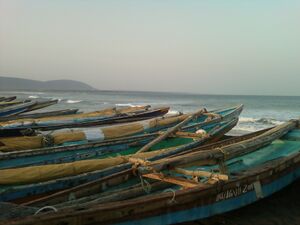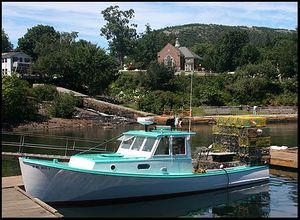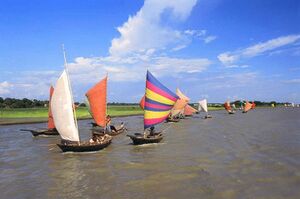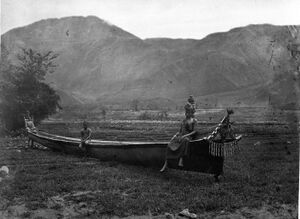قارب
القارب هو إحدى وسائل التنقل النهرية والبحرية. عادة يكون صغيراً، فهو أصغر حجماً من السفن. السفن عادة ما تحمل على متنها بعض القوارب حيث تستخدم كقوارب للنجاة.
يتألف القارب من تركيب يسمح له طفو، وأنظمة دفع، مثل المجاذيف، والأشرعة، وغيرها.
الأنواع
Boats can be categorized into three main types:
- Unpowered or human-powered. Unpowered craft include rafts meant for one-way downstream travel. Human-powered boats include canoes, kayaks, gondolas and boats propelled by poles like a punt.
- Sailboats, propelled mainly by means of sails.
- Motorboats, propelled by mechanical means, such as engines.
المصطلحات
The hull is the main, and in some cases only, structural component of a boat. It provides both capacity and buoyancy. The keel is a boat's "backbone", a lengthwise structural member to which the perpendicular frames are fixed. On most boats a deck covers the hull, in part or whole. While a ship often has several decks, a boat is unlikely to have more than one. Above the deck are often lifelines connected to stanchions, bulwarks perhaps topped by gunnels, or some combination of the two. A cabin may protrude above the deck forward, aft, along the centerline, or covering much of the length of the boat. Vertical structures dividing the internal spaces are known as bulkheads.
The forward end of a boat is called the bow, the aft end the stern. Facing forward the right side is referred to as starboard and the left side as port.
مواد البناء

Until the mid-19th century most boats were made of natural materials, primarily wood, although reed, bark and animal skins were also used. Early boats include the bound-reed style of boat seen in Ancient Egypt, the birch bark canoe, the animal hide-covered kayak[1] and coracle and the dugout canoe made from a single log.
By the mid-19th century, many boats had been built with iron or steel frames but still planked in wood. In 1855 ferro-cement boat construction was patented by the French, who coined the name "ferciment". This is a system by which a steel or iron wire framework is built in the shape of a boat's hull and covered over with cement. Reinforced with bulkheads and other internal structure it is strong but heavy, easily repaired, and, if sealed properly, will not leak or corrode.[بحاجة لمصدر]
As the forests of Britain and Europe continued to be over-harvested to supply the keels of larger wooden boats, and the Bessemer process (patented in 1855) cheapened the cost of steel, steel ships and boats began to be more common. By the 1930s boats built entirely of steel from frames to plating were seen replacing wooden boats in many industrial uses and fishing fleets. Private recreational boats of steel remain uncommon. In 1895 WH Mullins produced steel boats of galvanized iron and by 1930 became the world's largest producer of pleasure boats.
Mullins also offered boats in aluminum from 1895 through 1899 and once again in the 1920s,[2] but it wasn't until the mid-20th century that aluminium gained widespread popularity. Though much more expensive than steel, aluminum alloys exist that do not corrode in salt water, allowing a similar load carrying capacity to steel at much less weight.
Around the mid-1960s, boats made of fiberglass (aka "glassfibre") became popular, especially for recreational boats. Fiberglass is also known as "GRP" (glass-reinforced plastic) in the UK, and "FRP" (for fiber-reinforced plastic) in the US. Fiberglass boats are strong, and do not rust, corrode, or rot. Instead, they are susceptible to structural degradation from sunlight and extremes in temperature over their lifespan. Fiberglass structures can be made stiffer with sandwich panels, where the fiberglass encloses a lightweight core such as balsa[3] or foam.
Cold moulding is a modern construction method, using wood as the structural component. In cold moulding very thin strips of wood are layered over a form. Each layer is coated with resin, followed by another directionally alternating layer laid on top. Subsequent layers may be stapled or otherwise mechanically fastened to the previous, or weighted or vacuum bagged to provide compression and stabilization until the resin sets.
الدفع
The most common means of boat propulsion are as follows:
- Engine
- Inboard motor
- Stern drive (Inboard/outboard)
- Outboard motor
- Paddle wheel
- Water jet (jetboat, personal water craft)
- Fan (hovercraft, air boat)
- Man (rowing, paddling, setting pole etc.)
- Wind (sailing)
الطفو
A boat displaces its weight in water, regardless whether it is made of wood, steel, fiberglass, or even concrete. If weight is added to the boat, the volume of the hull drawn below the waterline will increase to keep the balance above and below the surface equal. Boats have a natural or designed level of buoyancy. Exceeding it will cause the boat first to ride lower in the water, second to take on water more readily than when properly loaded, and ultimately, if overloaded by any combination of structure, cargo, and water, sink.
As commercial vessels must be correctly loaded to be safe, and as the sea becomes less buoyant in brackish areas such as the Baltic, the Plimsoll line was introduced to prevent overloading.
تصنيف الاتحاد الأوروپي
Since 1998 all new leisure boats and barges built in Europe between 2.5m and 24m must comply with the EU's Recreational Craft Directive (RCD). The Directive establishes four categories that permit the allowable wind and wave conditions for vessels in each class:[4]
- Class A - the boat may safely navigate any waters.
- Class B - the boat is limited to offshore navigation. (Winds up to Force 8 & waves up to 4 metres)
- Class C - the boat is limited to inshore (coastal) navigation. (Winds up to Force 6 & waves up to 2 metres)
- Class D - the boat is limited to rivers, canals and small lakes. (Winds up to Force 4 & waves up to 0.5 metres)
انظر أيضاً
- Abora
- Barge
- Cabin cruiser
- Canoe
- Car float
- Coracle
- Dinghy
- Dory
- Fishing vessel
- Flatboat
- Halkett boat
- Inflatable boat
- Kayak
- Launch (boat)
- Lifeboat
- Lighter
- Log canoe
- Narrowboat
- Naval architecture
- Panga (boat)
- Pirogue
- Poveiro
- Rescue craft
- Riverboat
- Rowing
- Sailboat
- Sampan
- Ship
- Ship's boat
- Skiff
- Tour boat
- Traditional fishing boats
- Tûranor PlanetSolar
- Watercraft
- Yacht
المراجع
- ^ Streever, Bill (2009). Cold: Adventures in the World's Frozen Places. New York: Little, Brown and Company. p. 154.
- ^ WH Mullins boat history, Salem Ohio
- ^ .. as in the Iroqois catamaran
- ^ "The Barge Buyer's Handbook" - DBA publications ISBN 9780953281954
External links
- University of Washington Libraries Digital Collections – Freshwater and Marine Image Bank, (enter search term "vessels" for images of boats and vessels.)



